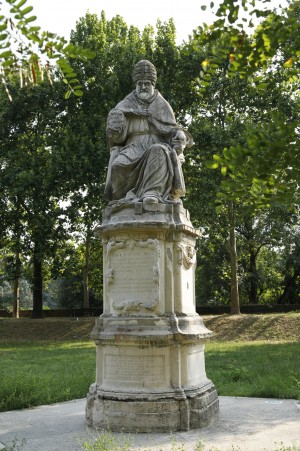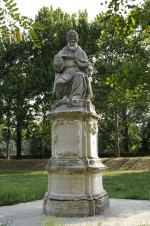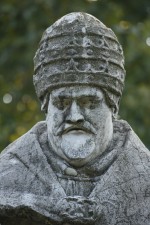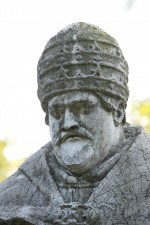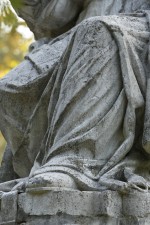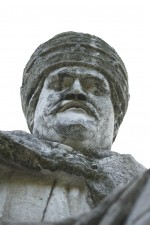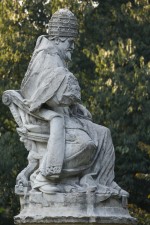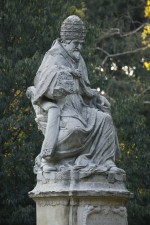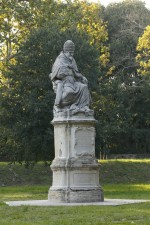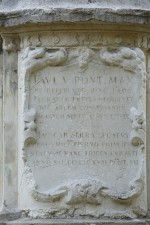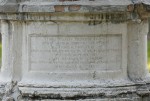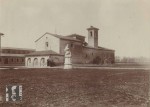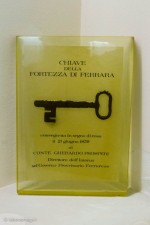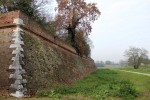Monumental statue of Paul V
Completed in 1618 by Giovanni Lucca Genovese, the statue of Pope Paul V actually has quite a turbulent history: from the sudden death of the artist to the numerous times it was toppled, buried and exhumed, damaged and even abandoned for decades on end.
A troubled past
The statue of Pope Paul V was erected in October of 1618 in the centre of the large Piazza d’Armi of the just-finished papal fortress, complete with an inaugural ceremony in the presence of the Pope’s army, commanded by general Mario Farnese. The monument is mentioned for the first time by historian and scholar Marco Antonio Guarini, whose 1621 Compendio describes the inscription on the pedestal:
Paulus Quintus Pont. Max.
Ne recedente hinc Pado
Ferrariae tutela recederet,
Hic arcem construendo,
Martem Neptuno substituit.
Iacobus Card. Serra Legatus
Providentiss. Principi,
Statuam hanc erigen. curavit,
Anno Sal. MDCXVIII Pont. XIII
Pauli Sabelli Principis Albani,
Eiq'; in armorum imperio suffecti
Federici Fratris,
Quorum consilium, et cura
In Arcis constructione plurimum enituit,
Lapis memoriam tuetur.
Hoc monumentum ad posteritatem extare voluit
Idem Cardinalis Legatus
To date, we know of no other works by the artist, the ‘talented sculptor’ Giovanni Lucca Genovese (assisted, for this project, by Serafino Colli), nor do we have any biographical information about him, aside from the curious and unsettling story told by Agostino Faustini in 1655 amid the pages of his Historie di Ferrara:
At that time, Giovanni Lucca Genovese, a talented sculptor, having completed the marble statue of the Pope, which can be seen in the fortress, died suddenly. Because the skin of his body turned different colours, no one believed he was dead, so he was wrapped in warm cloth and taken to the Chapter House of the Order of Saint Paul with many men, who watched him. There, once the night passed, the next day they saw that he was really dead, and, seeking the cause of the variation of those colours in a dead body, some doctors said that it was brought about by the alcoholic spirits that he enjoyed drinking in large quantities, with the addition of tobacco smoked, which he chased it with.
Poor Genovese, dying just after having finished the statue, which in turn would undergo a series of unfortunate events. Knocked down on the night of 24 September 1796 by Napoleon’s men and buried in a ditch near the pedestal, the statue was dug up and placed back in its rightful place by the Austrians in 1815. Thanks to the sensitivity of a local sculptor and professor named Giuseppe Ferrari, the statue was rescued the day after the destruction of the bastions of the papal citadel oriented towards the city (April 1860). Donated to the municipality, along with other random pieces of marble from the fortress, the matter of how to transport it to its new location arose. As to where it was to be placed, the idea came up to move it to the courtyard of the Palazzo dei Diamanti.
The excessive costs of so doing immediately provoked opposition in the municipal offices, quite well represented by the eloquent position taken by the mayor on 9 May 1864:
The putting into practice of what has been stated for the transport of the statue of Pope Paul V...has been shown to be...so onerous that it could not be sustained by the municipality. To which it should be added that the aforementioned statue, being of little value as a work of art, and not knowing where to place it as an ornament, and not being any more than a historical reminder, it would be advised to leave it where it currently stands (Guidi, p. 35).
And so it was. Struck by a bomb in 1944, the marble rendering of Paul V fell into a chasm created by the explosion, and was subsequently buried as the result of another bombing. There it remained, under dirt and rubble until April of 1949, when the restoration work requested and monitored by professor Gualtiero Medri, former Government Commissioner of the Provincial Delegation of Homeland History of Ferrara began. After being relegated for over half a century (until September 2002) to the garden of the Gesù Bambino di Praga Nursery School, in the nearby Via Castel Tedaldo (along with two volutes from the base, placed instead in the garden of Palazzo dei Diamanti), the monument was moved to the green space defined by the Baluardo di San Paolo and the Baluardo di Santa Maria, along Viale IV Novembre, in April 2003. The restoration was carried out thanks to the cultural and financial synergy of public and private organisations, especially the Museums of Ancient Art of Ferrara and the local Monumental Heritage and City Planning Departments, the Ferrariae Decus and Italia Nostra associations, the Fondazione Cassa di Risparmio, and the Superintendents of Historic Artwork and Architecture.
Paul V up close
The pope is portrayed as seated, in the act of benediction, with the classic papal tiara on his head and a baroque Van Dyke beard on his face. He doesn’t seem to sit comfortably on his chair, but is rather characterised by a ‘calm motion that, starting from his right foot, propels him forward, almost as if he were about to stand up, thereby highlighting the movement of the blessing’ (Lopresti).
Imposing, solid and massive, the marble figure is in contrast with the very ornate gestatorial chair, the back of which, framed by two back rests with lion's heads, bears the crowned eagle that was the coat of arms of Borghese princes. On the lower part, a beautiful figure of a dragon, equally heraldic, with a puffed-up body and webbed feet (the face unfortunately is very abraded) seems almost to rest with its wings outstretched. At each side is a griffin; the one on the left seems slightly more prominent. The throne looks as if it was made at the workshop of a architect/furniture maker with a capricious mannerist imagination, and the face, though damaged, reveals some finesse both in terms of its execution and in terms of ‘psychological introspection’ (Scardino, p. 29).
Not far from the monument to Paolo V, visitors can see the small marble obelisk that stands as a monument in memory of Giacomo Succi (landowner), Domenico Malagutti (doctor) and Luigi Parmeggiani (innkeeper), Ferrara-born heroes of the Italian Risorgimento and Mazzini sympathisers who were shot by the Austrians on 16 March 1853 outside the Porta del Soccorso, one of the entry points to the papal fortress. The bas-relief by Gianvito Saladino, on the initiative of Ferrariae Deus, was inaugurated on 16 March 2011 as part of the festivities celebrating the 150th anniversary of the unification of Italy.
Bibliography
- Marco Antonio Guarini, Compendio Historico dell'origine, accrescimento e prerogative delle chiese e Luoghi Pij della Città e Diocesi di Ferrara, heredi di Vottorio Baldini, Ferrara 1621
- Agostino Faustini, Delle Historie di Ferrara, Ferrara 1655
- Laura Guidi, Il monumento a Paolo V dopo l'Unità d'Italia, in Marica Peron, La Fortezza del Papa. Ferrara 1598-1859, Liberty House, Ferrara 1990
- Lucio Scardino, Il monumento a Paolo V nella Fortezza: un'intricata vicenda “critica”, in Marica Peron, La Fortezza del Papa. Ferrara 1598-1859, Liberty House, Ferrara 1990
- Berenice Giovannucci Vigi, Scultura e scultori a Ferrara, 1598-1796, Motta, Milano 2004
- Elisabetta Lopresti, Il restauro del monumento di Paolo V per la Fortezza di Ferrara in Ferrara. Voci di una città, 6 2004
Sitography
- https://rivista.fondazionecarife.it/component/k2/item/119-ritratto-di-pontefice
Fototeca
Related Themes
Compiling entity
- Assessorato alla Cultura e al Turismo, Comune di Ferrara

